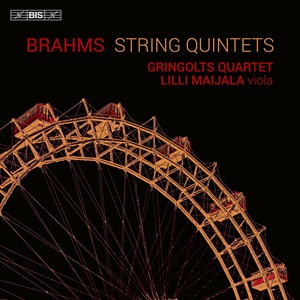
Johannes Brahms (1833-1897)
String Quintet No 1 in F major, Op 88 (1882)
String Quintet No 2 in G major, Op 111 (1890)
Gringolts Quartet & Lilli Maijala (viola)
rec. 2023, Reformierte Kirche, Marthalen, Switzerland
BIS 2727 SACD [61]
Brahms had a special attachment to the first of these string quintets, considering it his best work, whereas among his chamber music compositions I personally prefer his first string sextet, first cello sonata and the clarinet quintet. Be that as it may, these are very fine pieces, suffused with typically warm, soulful Brahmsian melodies, and they are here ideally performed and recorded in beautiful sound. The broad tune of the first movement and the doleful, melancholy opening Sarabande of the slow movement are feelingly delivered, the latter book-ending the little Allegretto vivace dance like a reversal of the conventional Scherzo form. Tuning and ensemble are immaculate and balances among the instruments ideal, allowing the warm, buzzing sonorities of the extra viola to make their mark. The players adapt effortlessly to the disparate range of style Brahms melds into a coherent unity, from the surging hyper-Romanticism of the “Grave ed appassionato” passage of the middle movement to the quasi Bachian/baroque fugal finale, and the concluding 9/8 Presto is attacked con gusto.
The second quintet is perhaps less instantly approachable and indeed prompted a mixed response when first performed. It is a darker work and the Gringolts capture the nervous agitation of the first movement perfectly, always pressing forward but also giving full weight to the fleeting passages of consolation couched in waltz form. They play the stately, funereal slow march which is the second movement with intensity, paying close attention to legato and dynamics; the concerted passage beginning at 4:15 is executed with great power. The third movement is another sombre affair, with an ostinato “dying fall” theme, heavily underlined by Claudius Herrmann’s rich cello. The finale offers a little relief in the form of dancing semiquavers, but their dance is halting and interrupted. It is a strange work, given fine advocacy here.
My only previous recording of these works was that by the Ludwig Quartet with violist Bruno Pasquier on Naxos, made back in 1995. It may be nearly thirty years old, but it is in excellent sound and if anything I like their extra flexibility with tempi a little more than the Gringolts’ manner; in the first movement of No 1, for example, they sometimes press on then relax most beguilingly and they are just as movingly elegiac in the autumnal slow movements. In fact, their more Romantic demeanour appeals more to my taste than the Gringolts’. I would not say that this new BIS recording displaces the Naxos recording, except in terms of offering multichannel sound.
This is packaged in a slim, cardboard, eco-friendly case. I like neither the fact that it is oversized so does not fit onto normal CD shelves nor that the SACD is in one of those adhesive envelopes which are awkward to open.
Ralph Moore
Buying this recording via a link below generates revenue for MWI and helps us keep free access to the site



Gringolts Quartet:
Ilya Gringolts (violin)
Anahit Kurtikyan (violin)
Silvia Simionescu (viola)
Claudius Herrmann (cello)

















